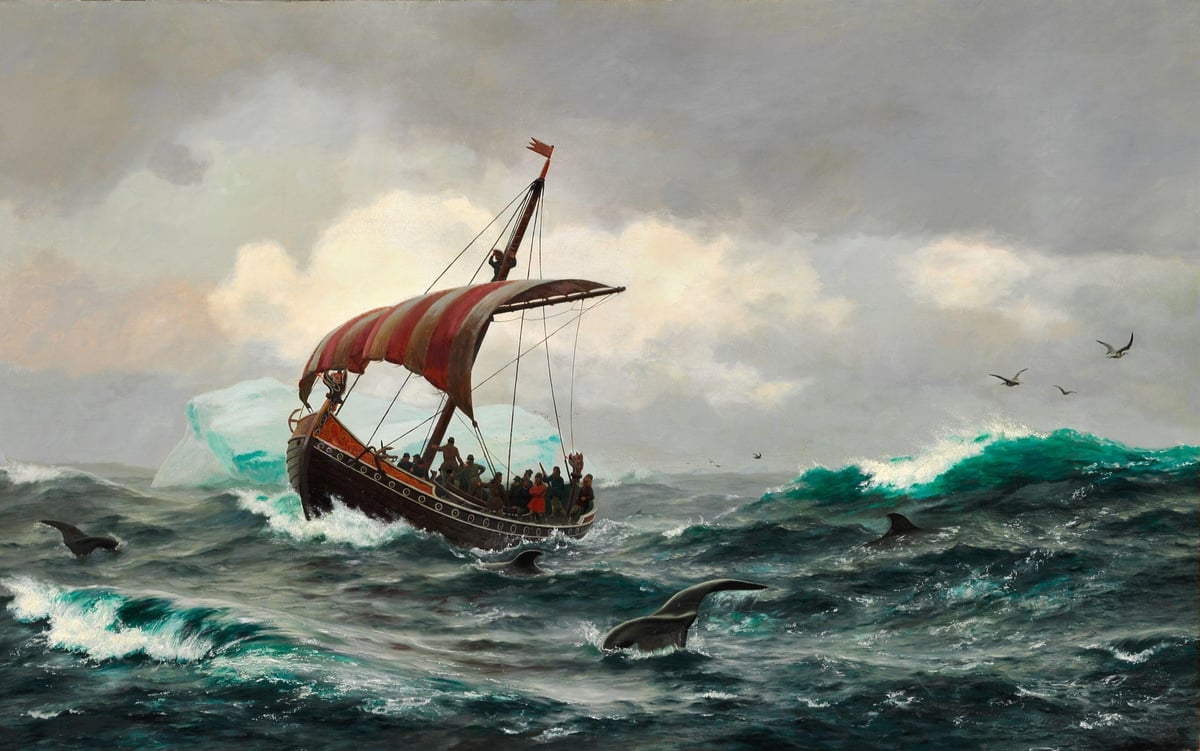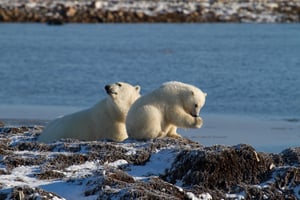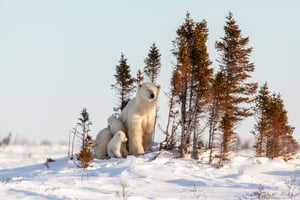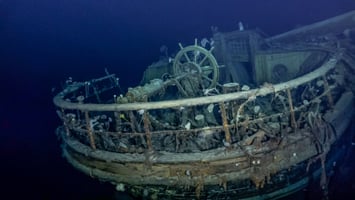Do you and your family enjoy nature and wildlife documentaries? Learning the strange quirks that...
Many people now recognize that Vikings were the first Europeans to reach the new world but did you know that it was Baffin Island that they first saw as they left Greenland.
Some even know the story of Leif Erikson, but he wasn’t the first to set eyes on the Americas. He was retracing the steps of another.
Join us as we explore the stories of the first Vikings to reach the New World.
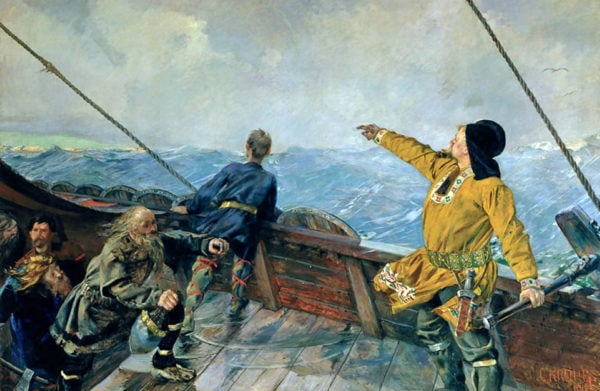
The Legendary Explorers
The first legendary figure to set their eyes on a new and undiscovered land was a Norse-Icelandic man named Bjarni Herjolfsson. Nearly 500 years before Columbus sailed from Spain, Nordic sagas tell of the figures that first discovered the New World.
These literary histories like the Saga of Erik the Red and the Greenlanders Saga, tell the story of the Vikings most exciting mythologies and chronicles the events of the most infamous figures like Ragnor Lothbrok. One of these tales tells of merchant captain who accidentally set his eyes on a strange land.
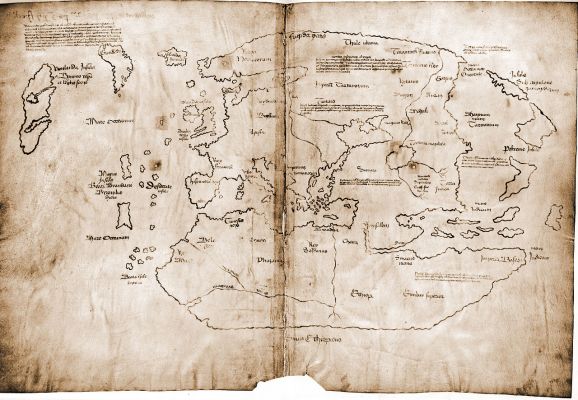
Viking Map includes Baffin Island on far LEFT (https://en.wikipedia.org/wiki/File:Vinland_Map_HiRes.jpg)
Bjarni Herjolfsson was a Norse-Icelandic who would sail from his home in Norway to visit his parents in Iceland each summer. When he arrived one year he learned that his parents had travelled with Erik the Red to colonize the newly discovered island of Greenland.
But in the summer of 986, he had no map or compass and was blown off course by a storm. To some, this might seem like he was unprepared, but what’s important to recognize is just how comfortable the Vikings were with navigating these waters and how often they were travelling among the Nordic lands. It might seem inevitable that they would accidentally discover the Americas.
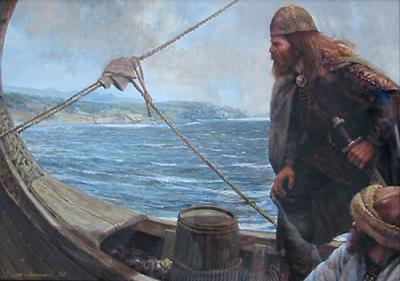
(https://archive-de-midgard.skyrock.com/40.html)
But while the Caribbean receives recognition for Columbus’ discovery and Newfoundland has the historic site of L’Anse Aux Meadows, but it was Baffin Island that any European first saw.
Blown off course, Bjarni saw a land covered with mountains but despite his crews’ begging, they never stepped off the boat and explored. Bjarni was eager to regain his course and reach his parents. He would settle with his parents but his discovery interested few people in this isolated settlement.
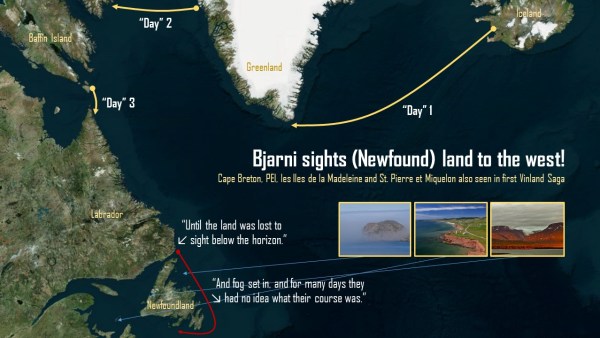
(https://lavalhallalujah.wordpress.com/2016/02/18/bjarni-sights-newfound-land-to-the-west/)
It wasn’t until he returned to Norway that his story would spark intrigue across the Viking world. And it was the new generation of Greenlanders that this particularly captivated.
The next to pick up this adventure was Leif Erikson. The son of Erik the Red who was first to colonize Greenland, came from a long line of explorers. Leif’s ancestors had discovered Iceland and later settled their after his grandfather was banished from Norway for murder. Leif’s father, Erik, was then banished from Iceland for murder, leading his to settle the strange and difficult land called Greenland at the extent of the Norse world.
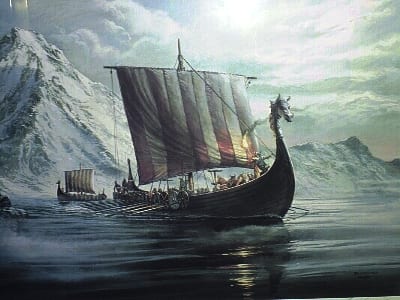
(http://www.medievalists.net/2012/02/could-vikings-have-navigated-under-foggy-and-cloudy-conditions-by-skylight-polarization/)
You can imagine that stories of a new land to discover further west must have fascinated Leif and seemed his family duty to explore it. But it was an accident that led Leif to the New World. According to the Saga of Erik the Red, Leif saw Vinland (the name for the lands beyond Greenland) for the first time when he was blown off course on a royal mission to introduce Christianity to Greenland. He would rescue two Norse shipwrecked sailors and would make it back to Greenland.
This would grip Leif’s imagination and soon he sought out Bjarni and would buy his ship, hire a crew, and set sail to retrace Bjarni’s voyage. And this would lead to his legendary expedition.
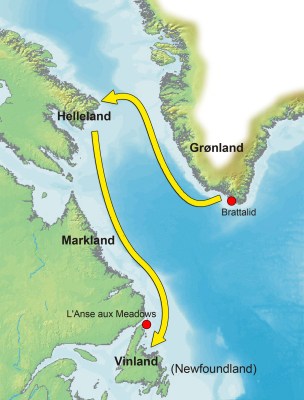
(https://tigertranscript.com/6148/features/viking-adventures-in-north-america/)
He visited first in a land he called Helluland, “Flat Rock Land.” This was Baffin Island and they were looking to the Arctic Cordillera mountain range. Though they jet high above the water forming numerous fiords, they are often flatted on top from the weight of the enormous glaciers and icecaps like Penny Ice Cap that formed and carved out this dramatic geography.
His voyage would continue south and land in a densely forested place they called Markland; “Forest Land” believed to be Labrador. After two more days at sea, they came to an island with a mild climate and plentiful in fish. As they explored the found the land was covered in vines and grapes, so they named it Vinland and now we call it Newfoundland.
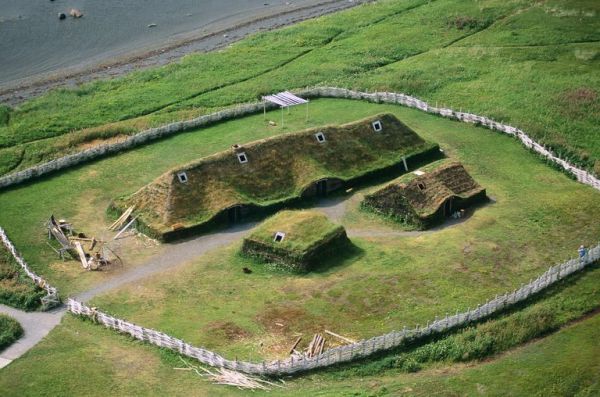
(https://tigertranscript.com/6148/features/viking-adventures-in-north-america/)
They would build a settlement that future Norse visitors would call “Leif’s Booths” and after spending a winter here, they would sail back to Greenland with a cargo of grapes and timber. Leif’s exploits would earn him enormous prestige and his legend would be immortalized in the Norse Sagas.
Lastly comes Thorfinn Karlsefni, an Icelander who traced his lineage to Ragnor Lothbrok. In 1010 AD, would follow Leif’s route in a short-lived attempt to create a permanent settlement in Vinland. Thorfinn came to Greenland and met his future wife Gudrid Thorbjarnardottir who was under the care of Leif Erikson.
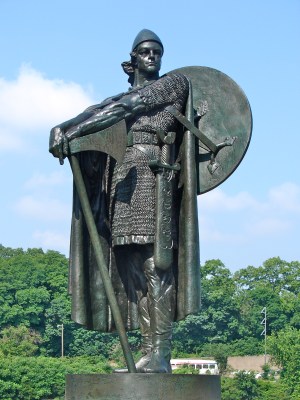
(https://en.wikipedia.org/wiki/Thorfinn_Karlsefni)
After passing through the lands of Helluland, Markland and reaching Vinland they would build a settlement. The exact location of the settlement is unknown but it is believed to be the Norse settlement of L’Anse Aux Meadows, Newfoundland.
Here Gudrid had a child with Thorfinn, named Snorri, and this was the first European to be born in the New World. Incredibly, since this is a true historic figure, many Icelandic people can trace their family roots to him. If fact, people with Icelandic heritage is offered the chance for a free trip to Iceland to explore their history, called the Snorri Program.
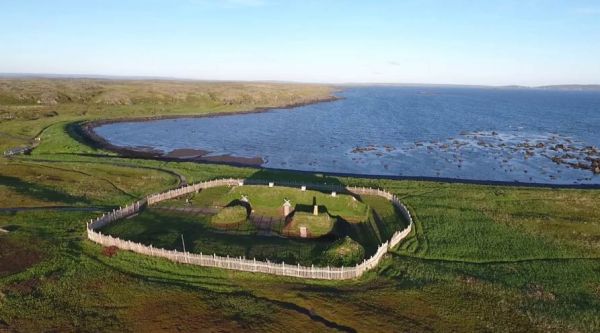
(https://www.ancient-origins.net/ancient-places-europe/lanse-aux-meadows-0010742)
After three years the settlement felt they needed to leave after a battle with native peoples. Despite all they had created they knew they’d be under constant threat from hostile relations with the locals.
Incredibly, there is an Inuit account of an interaction with Vikings that seems remarkably similar.
“[S] oon the kayaker set out his spear in good earnest, and killed him on the spot. When winter came, it was a general belief that the Kavdlunait would come and avenge the death of their countrymen.” *
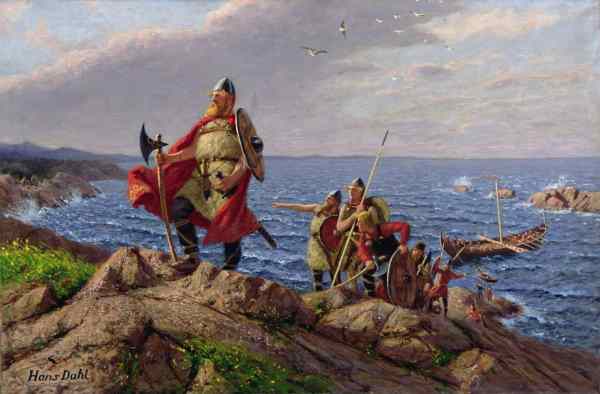
(https://coachkampsky.wordpress.com/powerpoints/)
Helluland
This was the name given to the first land reached beyond the known world. The Vikings called the entire unknown land Vinland but Helluland and Markland seem to refer to provinces or territories within Vinland. To the Vikings, a term given to Norse mariners as a general reference to most Scandinavian sailors, it was all a new land with new peoples.
A passage from the Saga of Erik the Red describes this new route west and the wonders they saw:
“They sailed away from land; then to Vestribygd and to Bjarneyjar (the Bear Islands). Then they sailed away from Bjarneyjar with northerly winds. They were out at sea two half-day. Then they came to land, and rowed along it in boats, and explored it, and found there flat stones. Polar-foxes were there in abundance. This land they gave name to, and called it Helluland.”**
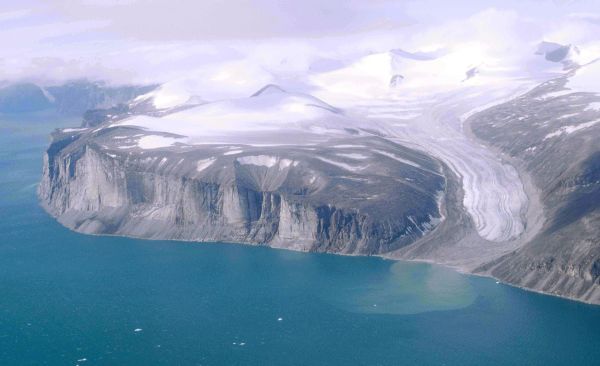
(https://kl.m.wikipedia.org/wiki/Fiileq:Baffin_Island_Northeast_Coast_1997-08-07.jpg)
To many Norse, the idea of expansion and exploration was innate to their culture. They came from a tough land that allowed only limited farming seasons, so they were often looking for new lands to settle. They believed that they needed to do something of mythical heights to become remembered and honoured after death. And for these explorers, their legacy does live on.
Beyond the testimony from the sagas, it is certain that there were interactions between the Norse and the pre-Inuit peoples. The sagas refer to a number of native peoples that they name ‘Skraelings’. In the times of Leif Erikson and Thorfinn, they would have met the Dorset people, a proto-Inuit people who disappeared soon after this time.
But as the Thule people quickly travelled east from Alaska, it is believed that part of this migration was based on knowledge of a source of steel in the east. This was both a meteor they mined and trade with Vikings that we know of from yarn fragments in the Canadian Arctic from Europe.
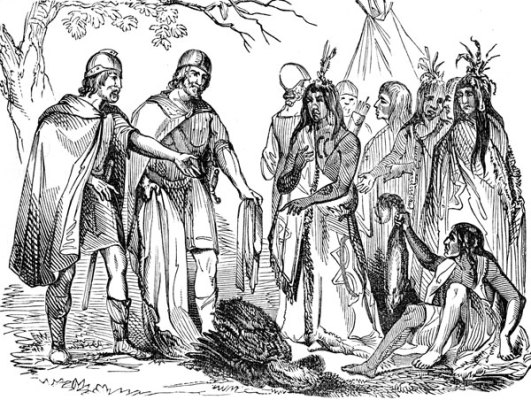
(https://metal-gaia.com/2012/10/29/vikings-and-native-americans/)
Explore In The Footsteps of History
Come explore Baffin Island and experience the first place that Europeans landed in the New World. Witness the culture of the Inuit whose ancestors established a trade route with Vikings.
Inuit culture is ancient and very much alive today. While the Vikings have receded into legend, come hear the oral histories of the Inuit who pass the stories onto new generations. Witness the art that has grown from lessons of the land and their traditions that honour the animals that cohabitate this land.
If you’re enthralled by the history and amazed by the stunning animals of the Arctic, then our safaris are an amazing opportunity to experience the north. Talk with our Inuit guides who know the land and the wildlife behaviours better than anyone. An article by Susan Nerberg, describing her experience talking with an Arctic Kingdom Inuit guide is a great example of the traditional knowledge they possess and how they apply it to their lives.
Are you interested in more Arctic explorers and polar navigation? Try our blog The History of the Northwest Passage: Arctic Explorers
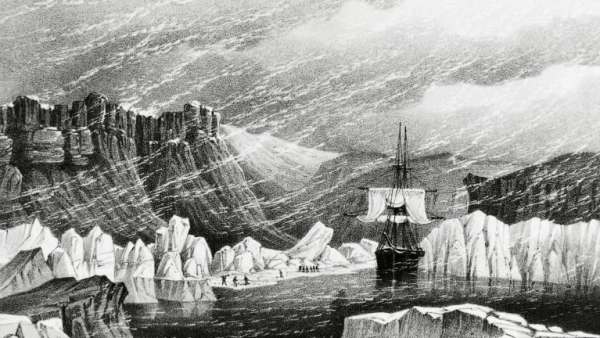
(https://www.history.com/topics/exploration/northwest-passage)
Experience The Arctic On A Safari
Get chances to view elusive Arctic wildlife and experience the majesty of the Arctic on safaris almost year-round. View all Arctic Safaris here.
Ready for adventure? Contact our Arctic Travel Advisors to book.
Are you still curious about the many wonders of the Arctic or looking for more interesting content then explore more blogs here!
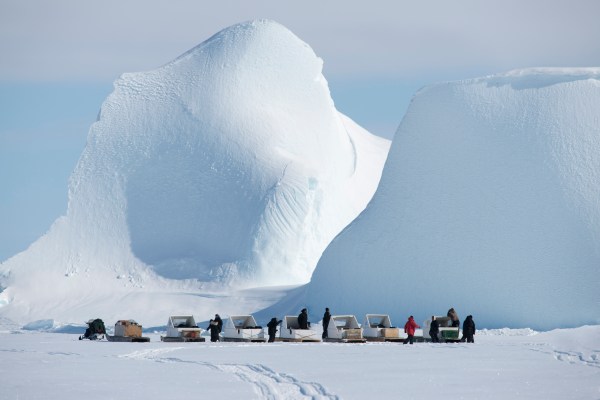
By: Mat Whitelaw
* Henry Rink Tales and Traditions of the Eskimo (Edinburgh: Blackwood, 1875, p. 310
**“The Saga of Erik the Red”. The Icelandic Saga Database. Sveinbjörn Þórðarson. Retrieved 12 January 2019. This land they gave name to, and called it Helluland (stone-land).

